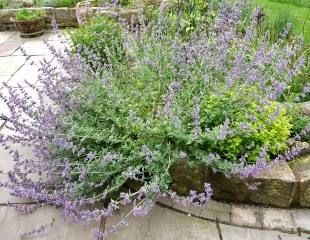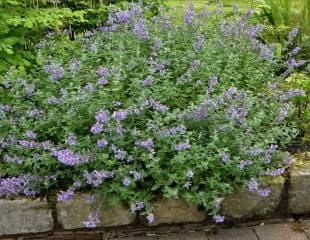What is the Chelsea Chop ?
Nepeta before Chelsea Chop

Nepeta is notorious for sprawling, especially as the summer goes on it can develop a bald spot in the middle. This Nepeta was not subjected to the Chelsea chop as a result it has grown quite large, and patchy in middle.
Nepeta after Chelsea Chop

I subjected this Nepeta to the Chelsea Chop and cut it back by around 10-20 cm. The precise timing of Chelsea chop is a bit weather dependent. The more advanced the plant is, the earlier to chop it. May is a good rule of thumb.
What is the purpose of the "Chelsea Chop"?
The Chelsea Chop has two main purposes.
First, it makes the plant more compact. This is useful for plants with a sprawling habit, such as Nepeta illustrated below. Using the Chelsea Chop will reduce the length of its flowering stems and so it's shorter and less top heavy. It will make the plant bush more, keep it in better shape for the summer.
Second, using the Chelsea chop, which is in effect cutting the plant back early in the summer, delays flowering because the plant needs to grow on more before it can flower. This means you can have some plants of the same type, flowering later to stagger the flowering period.
When to do the Chelsea chop? May is the traditional time to undertake the Chelsea Chop, so called because it's often done around the time of the Chelsea flower show.
How to do the Chelsea Chop
There are several ways to do the Chelsea chop.
One method is to cut the whole plant down by about 1/3. This delays the flowering overall the plant and makes the plant more bushy (you are in effect pruning it during its growing season.)
Alternatively, you can chop some of the plant's stems by a third, but don't chop other stems on the same plant, which will stagger flowering. The unchopped part will flower first and later the Chelsea chopped part.
Another way to do the Chelsea Chop is if you have two or more plants of the same variety, chop one but not the other. They will flower at different times staggering their flowering season.
Is it worth doing the Chelsea Chop? I think so, it really comes in handy to make plants bushier with more flowers and, especially towards the end of the season, when some plants, left unchecked, get leggy, it can be used to good effect.
One point to note is that using the Chelsea chop can result in smaller flowers, but usually more of them.
Sometimes, as a plant matures, it becomes a bit large for its allotted space, overshadowing neighbouring plants, which may not be ideal. The Chelsea Chop is one way to stop the plant overshadowing its neighbours; chop it in May or June and it will flower on shorter, bushier stems.
You should cut back later flowering perennials in late June/July, and use the Chelsea Chop in May for early flowering plants. Some plants will benefit from being cut back hard to encourage fresh new growth or a second flush see list below.
Which plants are suitable for the Chelsea Chop
There are many plants suitable for the Chelsea Chop or for cutting down/pruning during the growing season.
Plants suitable for the early Chelsea Chop: (May ) include: Asters, Monarda, Lavender, Nepeta, (Cat Mint) Echinacea purpurea, Artemisia, Sedum, Phlox, Helianthus, and Rudbeckia.
Plants suitable to cut back to get a second flush of flowers: There are several Perennials plants suitable for chopping in July to encourage a second flush of flowers. In these cases cut after flowering, and feed. A second flush is not always successful, and the flowering will not be as strong. In each case, just cut off the flower head stalk, which has flowered to encourage side shoots. This is suitable for Hollyhock, Astrantia, Delphinium, Digitalis, Campanula, and Penstemon.
Plants suitable to cut back because of poor foliage later in the season: There are some plants where it is a good idea to cut back to get new foliage. After they flower in July, cut back these plants almost to the ground. This is good where the foliage looks tatty and within 14-21 days new fresh foliage will shoot up which will look more attractive for the rest of the summer. This is suitable for Alchemilla mollis, Hardy Geranium (Cranesbill) and Salvia.
Don't waste the cuttings; the Chelsea chop cuttings are ideal to be used to propagate new plants. We can use the soft new growth that we removed as cuttings, and they will root very well. Sedum must be the easiest plants in the world to propagate by cuttings and to make new plants in this way. If you have one Sedum you shouldn't have to buy any more!
Sedum is just so easy; push the tip which has been cut off into the ground, and if kept moist, it will root where it is, with no more effort than making a hole with a dibber.
It is good fun and worth experimenting with the Chelsea chop and cutting back some plants by a third, others just some individual stems by a third, or on the same plant cut some stems and not others.
Chelsea Chop is not suitable for flowers which flower only once such as Peonies, Irises and Aquilegia.
